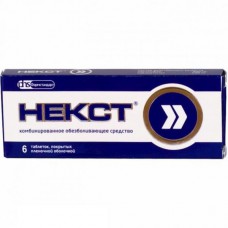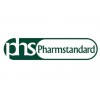Expiration date: 08/2026
Product form, composition and packaging
The tablets covered with a film cover of red color, oval, biconvex, with a risk, on cross-section a kernel of white or almost white color.
1 tablet contains:
ibuprofen 400 mg
paracetamol 200 mg
Excipients: calcium hydrogen phosphate 80 mg microcrystalline cellulose 39 mg, croscarmellose sodium 24.3 mg, hyprolose 44.8 mg, 12.1 mg of talc, magnesium stearate 7.3 mg, silica colloidal anhydrous 2.5 mg.
The film composition of the shell: red Opadry 20A250004 0.9 mg, Opadry II 85F19250 transparent 8.5 mg
Clinical and pharmacological group: NSAIDs in combination with analgesic-antipyretic
Pharmaco-therapeutic group: non-narcotic Analgesic agent (NSAID+narcotic analgesic)
Indications
- headache (including migraine);
- toothache;
- algomenorrhea (a morbid menses);
- neuralgia;
- myalgia;
- back pain;
- joint pain, pain in inflammatory and degenerative diseases of the musculoskeletal system;
- pain from bruises, sprains, dislocations, fractures;
- post-traumatic and postoperative pain syndrome;
- feverish conditions (including flu and colds).
Dosage regimen
Inside, after eating.
Adults: 1 tablet 3 times / day. The maximum daily dose - 3 tablets.
Children over 12 years (body weight more than 40 kg): 1 tablet 2 times/day.
The duration of treatment is no more than 3 days as a antipyretic and no more than 5 days - as an anesthetic. Continuation of treatment with the drug is possible only after consultation with the doctor.
Side effect
From the nervous system: headache, dizziness, sleep disorders, anxiety, depression.
From the side of cardiovascular system: tachycardia, increased blood pressure, heart failure.
From the respiratory system: shortness of breath, bronchospasm.
From the digestive tract: abdominal pain, nausea, vomiting, heartburn, decreased appetite, diarrhea or constipation, flatulence, ulceration of the gum mucosa, aphthous stomatitis, pancreatitis.
The senses: hearing loss, ringing or roaring in the ears, blurred vision, blurred vision or diplopia, dryness and irritation of the eye.
From the urinary system: acute renal failure, nephrotic syndrome, polyuria, cystitis.
Allergic reactions: skin rash, itching, allergic rhinitis, angioedema, multiform exudative erythema (including Stevens-Johnson syndrome), toxic epidermal necrolysis (Lyell's syndrome).
From the hematopoietic organs: anemia, thrombocytopenia, thrombocytopenic purpura, agranulocytosis, leukopenia, eosinophilia.
With prolonged use in high doses-hepatotoxic and nephrotoxic (hepatitis, interstitial nephritis and papillary necrosis) action; hemolytic anemia, aplastic anemia, methemoglobinemia, pancytopenia.
Contraindications to use
- hypersensitivity to the components of the drug;
- erosive and ulcerative diseases of the digestive tract (in the acute phase), gastrointestinal bleeding;
- severe hepatic and/or renal failure;
- blood clotting disorders (hemophilia, lengthening of bleeding time, tendency to bleeding, hemorrhagic diathesis);
- full or partial combination of bronchial asthma, recurrent polyposis of the nose and paranasal sinuses and intolerance of acetylsalicylic acid or other nonsteroidal anti-inflammatory drugs, including history;
- condition after coronary artery bypass grafting;
- confirmed hyperkalemia;
- the deficit glukozo-6-fosfatdegidrogenaza;
- pregnancy (III trimester);
- children under 12 years of age.
Caution: congestive heart failure; viral hepatitis, alcoholic liver disease, hepatic and/or renal failure moderate and mild, benign hyperbilirubinemia (Gilbert syndrome, Dubin-Johnson and Rotor), liver cirrhosis with portal hypertension, nephrotic syndrome; diabetes mellitus, peripheral artery disease, gastric ulcer and duodenal ulcer (in history); gastritis, enteritis, colitis; asthma, bronchospasm; old age; pregnancy (I and II trimestrah use only on prescription in cases when the potential benefit outweighs the potential risk), lactation (if necessary, use of the drug during lactation should stop breast-feeding).
Application during pregnancy and breast-feeding
The use of the drug in the third trimester of pregnancy is contraindicated.
If you need to use the drug in the I and II trimester of pregnancy should be careful - the use is possible only by appointment of a doctor in cases where the potential benefit exceeds the possible risk. In the period of breastfeeding if necessary, use of the drug should discontinue breast-feeding.
Application for violations of liver function
Caution: viral hepatitis, alcoholic liver disease, hepatic failure moderate and mild, benign hyperbilirubinemia (Gilbert syndrome, Dubin-Johnson and Rotor), liver cirrhosis with portal hypertension.
Application for violations of renal function
Caution: renal failure of moderate to mild severity, nephrotic syndrome.
Use in children
Contraindicated in children under 12 years.
Special instruction
Avoid the simultaneous use of the drug with other drugs containing paracetamol and/or nonsteroidal anti-inflammatory drugs.
In applying the drug more than 5-7 days, you should monitor the performance of peripheral blood and functional state of the liver.
Paracetamol distorts the results of laboratory tests of glucose and uric acid content in blood plasma.
If you have symptoms of NSAID-gastropathy shows careful monitoring, including conducting esophagogastroduodenoscopy, blood test with determination of hemoglobin and hematocrit, stool for occult blood.
If it is necessary to determine 17-ketosteroids, the drug should be canceled 48 hours before the study.
On the background of the drug, patients should refrain from all activities that require greater attention, rapid mental and motor responses.
During treatment is not recommended reception alkogolsoderzhaschih drinks.
Overdose
Symptoms: abdominal pain, nausea, vomiting, agitation or lethargy, drowsiness, confusion, tachycardia, arrhythmia, acute renal failure, metabolic acidosis, frequent urination, hyperthermia, headache, tremor or muscle twitching; increased activity of "liver" transaminases, increase in prothrombin time. If you suspect an overdose, you must immediately seek medical help.
Treatment: gastric lavage, followed by the appointment of activated charcoal; alkaline drink, forced diuresis, symptomatic therapy.
Drug interaction
Inductors of microsomal oxidation in the liver (phenytoin, ethanol, barbiturates, flumecinol, rifampicin, phenylbutazone, tricyclic antidepressants) increase the production of hydroxylated active metabolites, which leads to the possibility of severe intoxication in overdose.
Microsomal oxidation inhibitors (including cimetidine) reduce the risk of hepatotoxic action.
Myelotoxic drugs increase the manifestations of hematotoxicity of the drug.
The combination of ibuprofen with ethanol, glucocorticosteroids increases the risk of erosive and ulcerative lesions of the gastrointestinal tract.
Simultaneous use of paracetamol with ethanol increases the risk of acute pancreatitis.
Paracetamol and ibuprofen increase the effect of indirect anticoagulants and reduce the effectiveness of uricosuric drugs.
Prolonged use of barbiturates reduces the effectiveness of paracetamol. Diflunisal increases plasma concentrations of paracetamol by 50%, which increases the risk of hepatotoxicity.
Ibuprofen reduces hypotensive activity of vasodilators, natriuretic and diuretic-furosemide and hydrochlorothiazide.
Antacids and cholestyramine reduce the absorption of ibuprofen.
Ibuprofen enhances the effect of oral hypoglycemic agents and insulin.
Ibuprofen increases the concentration in blood of digoxin, drugs lithium and methotrexate.
While the appointment of acetylsalicylic acid, ibuprofen reduces inflammatory and antiplatelet effect.
Cefamandol, cefoperazone, cefotetan, valproic acid, plicamycin increase the frequency of gipoprotrombinemii.
Conditions of supply of pharmacies
The drug is allowed to use as a means of non-prescription.




